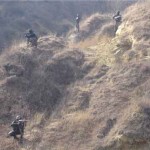And now, the interrogation of four villagers including a retired police inspector from Bhati Dhar and nearby villages has revealed that several militants past and present may have been using Bhati Dhar forest as a base for almost five years where they had modified nearly 30 caves for their hideout. Some villagers who frequented the forest with ration and other logistics are now missing.
The militants could not have remained so well entrenched in Bhati Dhar without local support. It shows a complete lack of area domination by the local units of the Army as otherwise to and fro movement of militants and their supplies should have been noticed and or interdicted. There appears to be a deliberate effort on part of the local commanders not to report militant activity less they get adversely sucked into it. Also, there were several ceasefire violations and infiltration attempts in Rajouri-Poonch especially in September and October, some of which were successful. Perhaps the militants were making a dash for the sanctuary in Bhati Dhar. A large number of mobile phones and communication equipment have been found in the hideout which eventually led the security forces there. How were transmissions not detected earlier?
Such a long and prolonged engagement affects the morale of the troops. After 26/11 when there was so much war hysteria, the Bhati Dhar episode is not good for national confidence. It brings back the scare of terror and the threat posed by it.
The Operational Approach
The terrain and other constraints notwithstanding, the Army’s ‘slow and steady’, ‘wear them out approach’, is causing them more fatique, strung out as they are in a cordon for so long. Not going in for the final push is prolonging the engagement and playing into the militant’s hand. It is giving them a halo which will be an elixir for other militants waiting across the LoC. Such a long and prolonged engagement affects the morale of the troops. After 26/11 when there was so much war hysteria, the Bhati Dhar episode is not good for national confidence. It brings back the scare of terror and the threat posed by it.
With militants now changing tactic and infiltrating literally from behind their backs, i.e. via Nepal and Bangladesh, the Army also needs to partially go back to some of its traditional methods like long range patrols and area domination which have become less frequent these days. In fact, to ‘terrorise’ the ‘terrorists’, more aggressive methods such as pounding them with artillery/mortar fire and use of helicopter gunships in uninhabited areas should be resorted to.
The lessons from Hill Kaka should be learnt. After all, from fortified hideouts there, several fidayeen attacks in J&K and the rest of the country were launched. With satellite phones the foreign terrorists had commuicated all over the world and a photograph of a militant posing in front of Red Fort in Delhi was found.
The group in Bhati Dhar being on the loose is an ominous sign, as they may well be on their way to carry out a sensational strike in the near future. Another such well trained group of six LeT terrorists who had trained with the Mumbai hit group is believed to be holed up somewhere in the mountains of North Kashmir, therefore it is imperative for the Security Forces to be on guard and deny them such staging areas as Bhati Dhar inside our territory. As already pointed out in my other article, snow warfare and commando training being imparted by the Pak Army’s elite Special Services Group(SSG) to select cadres will allow them to infiltrate and hold out in snow bound areas in the winters. The focus now is less on numbers and more on small but determined ‘crack’ groups which can launch swift and spectacular strikes and bring back focus on the Kashmir issue.
The lessons from Hill Kaka should be learnt.
Importantly, it is good sense to avoid own casualties but going into battle with that fixed mindest is detrimental for operational efficiency, for, it needlessly imposes restraint and caution leading to a situation such as this. By such long drawn action against the Indian Army the terrorists become a role model for future terrorist actions and budding ‘jehadis’ who are motivated by showing video recording of such stand-offs. These even create awe among their sympathisers and the locals residing in strife-torn states such as J&K. In the valley region, this is reflective in the high attendance in funeral processions of local mlitants who are seen as ‘freedom fighters’ and ‘martyrs’ to the so-called ‘cause’.
The present day modern Indian Army can take a leaf out of its earlier engagements with many a mujahideen and insurgent group-from J&K, Northeast to Sri Lanka in the era of the Self- Loading Rifle and in the absence of bullet-proof jackets and state-of-the-art surveillance equipment, intelligence gathering apparatus, etc.
At stake is the invincibility of the Indian Army, a stake too high for the LeT’s dream of carving an ‘Islamic Caliphate’ and planting its flag on the Red Fort. It can only be prevented by the redoubtable Indian Army.




